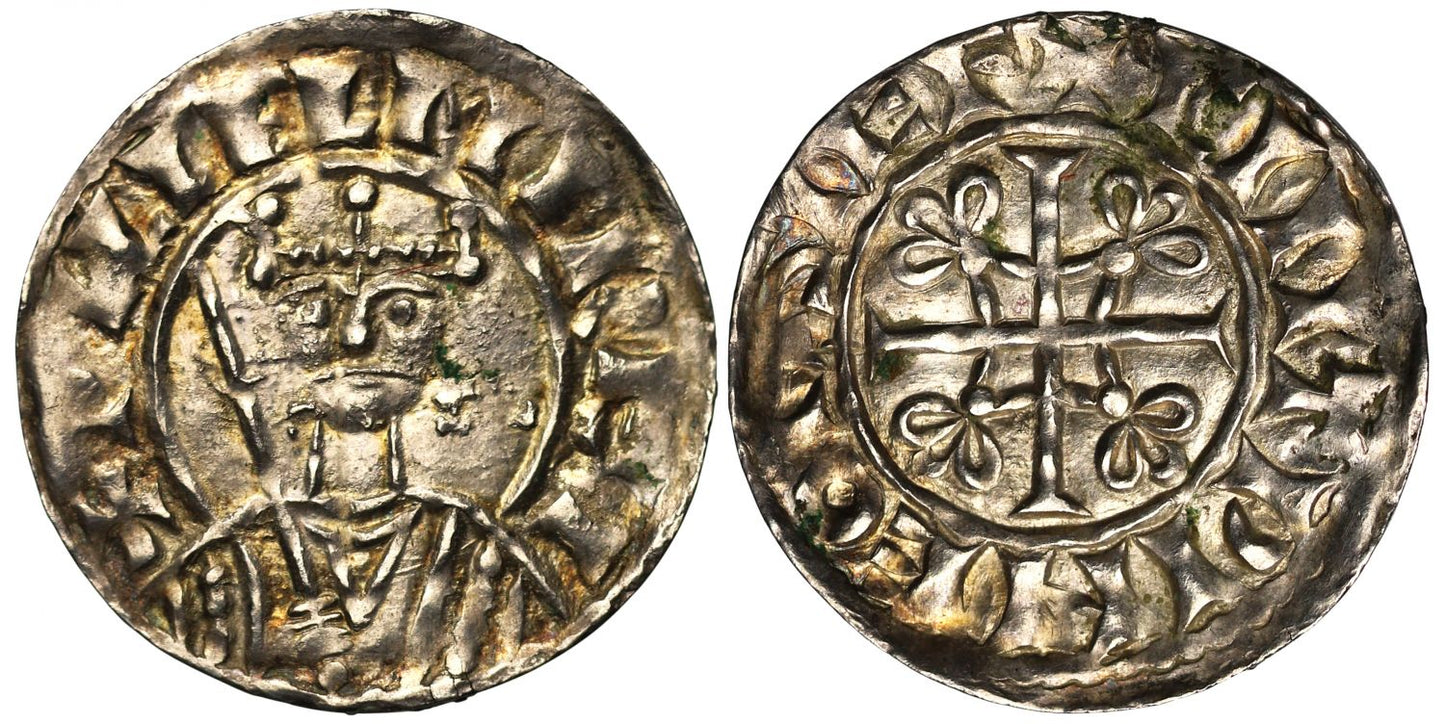FAQs
What makes a coin valuable?
I have coins to sell, what’s the next step?
How will my purchases be shipped?
What happens if I’m not entirely happy with my purchase?
William I Penny, Sword Type, Shaftesbury Mint, Moneyer Cintwine
William I (1066-87),silver sword type Penny (1077-80?), Shaftesbury Mint, Moneyer Centwine, facing crowned bust to edge of coin with sword resting on shoulder, legend commencing lower left with inner and outer linear circles surrounding both sides, +PILLELM REX I,rev.cross pattee over quadrilateral with incurved sides and fleury angles, +CIIITPINE ON SIEF, weight 1.09g (cf. SCBI 21:'M148 Yorkshire; BMC type VI; N.846; S.1255).Lightly toned, a couple of tiny green spots each side, good very fine and extremely rare.
The legends translate as "William King of the English" on obverse and on the reverse "Centwine of Shaftesbury."
Despite the transition from the Anglo-Saxon to the Norman period, numismatically the three-year change of coin types continued. The sword type of William is the sixth of the seven types attributed to this reign. According to North the Shaftesbury Mint had up to 7 moneyers active from type V in the reign of William the Conqueror.
The first Norman King of England, William the Conqueror born around 1028 was the son of Robert I of Normandy and Herleya. A descendant of Rollo, William became Duke of Normandy in 1035, he subsequently married Matilda of Flanders in the 1050s ensuring a powerful ally in that neighbouring region. After a protracted struggle and quashing rebellions, his hold over Normandy was eventually secure by 1060 and with appointment of supporting abbots and bishops in the Norman church, and he subsequently secured the region of Maine in 1062. William's first cousin once removed was the childless Edward the Confessor of England and from this family connection and that Edward had previously told him he would succeed, he assumed a claim to the throne of England over Harold Godwinson, who Edward had named as his successor on his deathbed in January 1066. William also claimed that Harold previously had promised the throne to him in the event of succession, Harold having sworn over holy relics in William's presence as depicted in the Bayeux tapestry. William therefore built up a powerful invasion force to cross the channel and fight for the right to rule England as of September 1066. He landed at Pevensey Bay and after setting up camp with a basic fort at Hastings he marched north to meet Harold at Senlac Hill at Battle, East Sussex on the 14thOctober. A battle raged for most of the day, with at one point a rumour spread that William was slain resulting in him having to remove his helmet and reveal he was alive and fighting, boosting the morale of the Normans for the final onslaught in which Harold perished, either from an arrow in the eye or cut down by a horseman. William then went on a military tour to put down local uprisings leading to his crowning in Westminster Abbey on Christmas Day. He made arrangements in London for governance for whenever he would be in Normandy, and by 1075 his hold on England was almost complete with many forts and castles constructed. His later years involved quelling other uprisings in Europe and difficulty with his eldest son Robert Curthose, but his most famous achievement in England was the preparation of the Domesday Book in 1086; a survey of the land and the land-owners and nobles within it, listing pre-conquest and current holders at that time. William died in September 1087 leading a campaign in northern France and was buried at Caen. Normandy was given to eldest son Robert, with England given to his next surviving son William Rufus.
Situated in Dorset nearly 25 miles north northwest of Dorchester on high ground, Shaftesbury is where Dunstan took the body of Edward the Martyr for interment after his death at Corfe Castle. Minting activity occurs from the reign of Aethelstan to King Stephen including a die link with the rare "BRYGIN" pieces.
Provenance:
Ex A. H. Baldwin and Son Ltd, purchased 2006.
FAQs
What makes a coin valuable?
I have coins to sell, what’s the next step?
How will my purchases be shipped?
What happens if I’m not entirely happy with my purchase?













